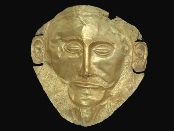
Site and content copyright © 2017 by Stylus Productions. All rights reserved.

THE HEROIC AGE OF ANCIENT GREECE
VIDEO LECTURES by Dr. William J. Neidinger
Few generations of any age, in any culture, have had such an impact that their deeds continued to be celebrated in poetry, painting, music, and sculpture millennia after that generation had passed away. The exploits of the heroes of ancient Greece were such that they defined the very concept of heroism itself for Greece and Rome. Yet in recent times as historians and archaeologists began to critically examine the literary accounts and material artifacts of Bronze Age Greece, discrepancies began to emerge between the literature that celebrated that heroic period and the physical remains. Some came to doubt even the existence of the greatest exploit of that era, the Trojan War.
In this series of lectures we will examine in detail the archaeological sites and artifacts of Bronze Age Greece (ca. 2000-1000 BC), and what the evidence tells us of the Heroic Age and the creation of the myths of the Heroic Age.
5 Lectures:
1. The Rise of Minoan Crete.
Around 2000 BC a number of colossal palaces were built across Crete; they were all destroyed by earthquakes three centuries later and immediately rebuilt. The palace builders of Minoan Crete established a wide Mediterranean trade network and a rule over the Aegean that later Greeks called the Minoan Thalassocracy.
2. Minoan Religion and Society.
Starting with Arthur Evans himself, there has been a relentless effort in academia to portray ancient Minoan Crete as a peace-loving, Great Mother-worshipping, nature-loving, matriarchal society. But there is sufficient evidence to suggest that the Minoans were warriors who venerated a Storm God and a female deity, the Mistress of the Palace.
3. The Rise of the Mycenaean Greeks.
The Greeks of the mainland were once the cultural understudies of the Minoans. But in short order the Mycenaean Greeks, having absorbed what they could from the Minoans, conquered Crete. The Greeks, whose wealth is attested by their grave goods, took to piracy and began raiding neighbors’ lands. The entire eastern Mediterranean was plunged into chaos in this Time of Troubles.
4. The Trojan War: The History.
In this Time of Troubles, Troy was sacked and laid waste. In this lecture we examine the archaeological evidence from Troy and the archival records of the Hittites and Egyptians for clues about the historicity of the Trojan War.
5. The Trojan War: The Legend.
If we accept the Trojan War as fact, we are still faced with the task of separating fact from fiction in the Iliad. Just how much of Homer’s Iliad is poetic license and how much reflects the reality of the war? In this lecture we unravel the mystery of Homer and his Iliad.
THE HEROIC AGE Series at AMAZON PRIME VIDEO

Lecture 3

Lecture 1

Lecture 2
THE HEROIC AGE Series also available on
amazon.co.uk

Lecture 4

Lecture 5





 Printed Book
Printed Book
 E-Book
E-Book
LECTURE NOTES
outline study guide now available as a printed book or E-Book from Amazon.com
Notes in PDF format will be provided with DVD purchase.
Watch THE HEROIC AGE
on Amazon Prime Video

Series also available on DVD:
$36.00
Buy item 049 DVD



